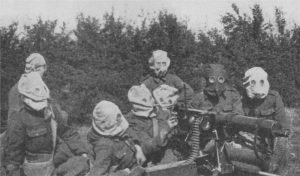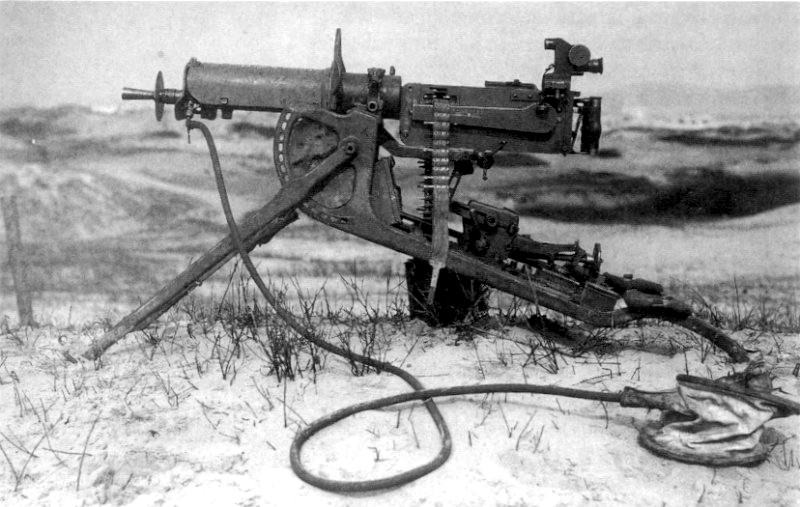The Machine Gun is remembered for its role in the carnage of the First Day of the Somme. The gun though was in its infancy as the First World War began. Invented just 30 years earlier, the Machine Gun was developed and refined as a weapon over the course of the First World War. Tactics were adapted as new types of the gun were produced. Synonymous with trench warfare, the machine gun was actually deployed reasonably sparsely at the beginning of the war, by the end it was deployed by the Germans at a rate of over 30 per kilometre of defensive lines.
The first machine gun had been invented by Maxim in the 1880’s. The American invention had been adopted by other countries but with much more enthusiasm in some of the major powers than in others. By the outbreak of war small cartridges of bullets were a possibility, effective range was anywhere from 500m to 1500m. The weapon, if used well, was potentially devastating.

Uses of Machine Guns
The early machine guns of the First World War were heavy. They required a crew to move them, fix them into position and aim, fire and reload them. The Germans arranged their machine guns on a regimental basis, giving control of their use to those on the ground. The same wasn’t replicated by the Western Allies. This gave the German machine gunners an advantage that created a myth that they had more, and superior, machine guns available. In truth, they just used them more effectively.
The Machine Guns were used in two ways. First in a defensive capacity they were fixed into position and used to create crossfire. If the guns were sited effectively and aimed accurately this would enable a ‘wall of fire’ in which bullets were flying through designated zones between waist and head height for an enemy soldier of average height. As the machine gun already had the capacity to fire 250 rounds per minute this was a deadly tactic that made advancing incredibly difficult. The wall of fire approach to defending was best illustrated by German machine gunners. At the Battle of Loos in 1915 and at the Battle of the Somme in 1916 the crossfire was deadly.
Second was as a means of supporting offensive troops. While the highly effective kill zone was at a range of around 500m the gun could fire further. As the war progressed the Machine Guns on the Western Front became employed as part of the creeping barrage tactic. By aiming upwards the machine gunner could fire over the head of advancing troops in a ellipse. This could be used to clear minefields, be aimed at trenches or directed at any enemy attempting a counter attack. This method relied on accurate battlefield information. The calculations for the arc of fire needed to be accurate in order to make sure that fire did not hit friendly forces. One way of ranging this type of fire was through use of ‘SOS’ flares that alerted machine gun crews to counter attacks or strong positions in the enemy line.

Development of Light Machine Guns
The Machine Gun had two major drawbacks. It was prone to jamming and it was a very heavy and cumbersome weapon. For it to be most effective, it needed to be a weapon that could be moved around the battlefield quickly. As the war drew on, both sides began to explore ways of making a lighter machine gun more readily available.
The Vickers Gun was the Machine Gun used by the British Army at the start of the war. With production having begun in 1912 the army deployed this gun, which weighed 20kg, in all theatres of war. It was used throughout the war and well into the twentieth century. It was popular with the soldiers, earning the nickname ‘Queen of the Battlefield’. On one occasion 10 Vickers Machine Guns sited at High Wood are believed to have fired over a million bullets in a 12 hour period fending off a German assault.
The British had the Lewis Gun in production as the war began. Weighing 12kg this could be carried around quite easily. The army didn’t have many of the Lewis Guns though. In 1915 each battalion had just 4 of the guns. Production was increased and by 1917 this had increased to 46. The design was also improved. The weight dropped to 9kg. The gun was now added to aircraft, armoured cars, motorcycles, built into tanks. The Royal Navy also deployed the Lewis Gun.
The Browning Automatic Rifle. The US Army used the Lewis Gun as they entered the war. They switched to the Browning Automatic Rifle in 1918 as it was much lighter and more reliable than the Lewis Gun. It had the ability to be carried and reloaded by just one soldier, a major advantage over the heavier guns.

Maschinengewehr 08 was the standard German Machine Gun of the First World War. It was based on Maxim’s original design. The Maschinengewehr 08 was modified over the course of the war with weight one of the areas that the Germans intended to improve. Production of this gun peaked at an incredible 14500 per month.
Machine Guns: Links
Encyclopedia 1914-18 has an article on Machine Guns written by Paul Cornish of the Imperial War Museum.
Popular Mechanics has an article about an unusual but used machine gun developed by the Italians.

